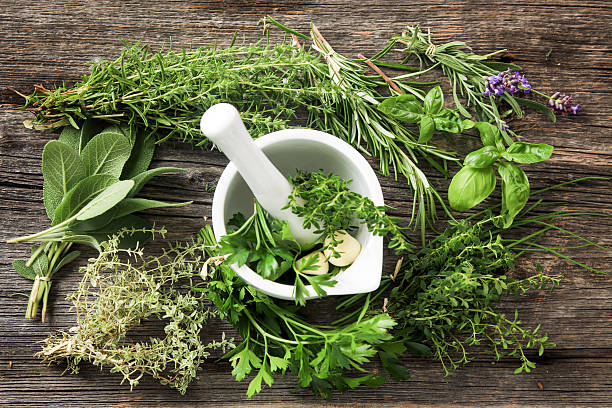Fresh herbs are a game-changer in the kitchen. They can elevate even the simplest dishes, adding vibrant flavors and aromas that dry herbs just can’t replicate. Whether you’re a seasoned chef or a beginner cook, using fresh herbs can instantly improve your meals. What’s even better? You can grow your own herbs at home, right in your kitchen or backyard, making them accessible year-round.
In this guide, we’ll introduce you to the joys of cooking with fresh herbs, offer tips on how to grow and care for them, and share recipes to help you incorporate herbs like basil, thyme, rosemary, and cilantro into both savory and sweet dishes.
Why Grow Your Own Fresh Herbs?
1. Flavor and Freshness
Fresh herbs are bursting with essential oils and natural flavors that dried herbs lack. They release their flavor when chopped or bruised, making them a powerful tool to enhance your cooking. Plus, fresh herbs can be added at the end of cooking to maintain their delicate taste, adding brightness to dishes.
2. Convenience
Imagine having fresh basil or rosemary just a few steps away from your stove. Growing your own herbs means you have access to them whenever you need, without the hassle of running to the store. They’re easy to care for and grow, and they don’t require a lot of space.
3. Cost-Effective
Buying fresh herbs at the grocery store can get expensive, especially if you only need a small amount. Growing your own means you can harvest exactly what you need, cutting down on waste and saving money in the long run.
4. Health Benefits
Herbs like basil, rosemary, and thyme are packed with antioxidants, vitamins, and other nutrients that can boost your health. For example, basil has anti-inflammatory properties, and thyme is rich in vitamin C. Growing them yourself means you can enjoy the healthiest, most nutritious herbs possible.
Tips for Growing Fresh Herbs
1. Choosing the Right Herbs
Some herbs are easier to grow indoors than others. If you’re just starting out, consider growing herbs like basil, parsley, thyme, rosemary, mint, cilantro, or chives. These are hardy and well-suited for windowsills or small garden spaces.
Tip: Keep in mind that some herbs, like mint, can be invasive, so it’s best to grow them in a separate pot to prevent them from overtaking other plants.
2. Providing the Right Environment
Most herbs thrive in a warm environment with plenty of sunlight. Place your herbs in a spot that gets at least 6 hours of sunlight a day. If you’re growing them indoors, a south-facing window is ideal. You can also use grow lights if sunlight is limited.
Tip: Herbs prefer well-draining soil. Be sure to use pots with drainage holes, and water them when the soil feels dry to the touch.
3. Harvesting and Pruning
To encourage healthy growth, regularly prune your herbs by cutting them back. Harvest leaves by pinching them off at the stem, taking only what you need. For herbs like basil, always cut above a leaf node to encourage new growth. Avoid harvesting more than one-third of the plant at once.
Tip: For rosemary, thyme, and other woody herbs, you can trim the stems to use in cooking or even turn them into fragrant skewers for grilling.
4. Storing Fresh Herbs
Fresh herbs don’t last long in the fridge, so it’s important to know how to store them properly. Here are some tips:
- Storing in Water: For soft herbs like basil, place them in a glass of water on the counter (like a bouquet) and change the water every few days. They’ll last longer this way.
- Refrigerating: For herbs like parsley and cilantro, wrap them in a damp paper towel and place them in a plastic bag or airtight container in the fridge.
- Freezing: You can also freeze fresh herbs. Chop them up and place them in ice cube trays with a bit of water or olive oil. This method works great for herbs like rosemary, thyme, and oregano.
Cooking with Fresh Herbs
Fresh herbs are incredibly versatile and can be used in a variety of dishes—both savory and sweet. Here’s how to incorporate some of the most popular herbs into your cooking:
1. Basil
Basil is one of the most beloved herbs in the culinary world, known for its fragrant, slightly peppery flavor. It pairs perfectly with tomatoes, mozzarella, and other Mediterranean ingredients.
Recipes to Try:
- Pesto: Blend fresh basil with garlic, pine nuts, Parmesan cheese, and olive oil to make a delicious pesto sauce. Toss with pasta or use as a spread for sandwiches.
- Caprese Salad: Combine fresh basil leaves with sliced tomatoes and mozzarella, drizzle with balsamic vinegar and olive oil for a simple, refreshing dish.
- Basil-Infused Lemonade: Muddle a few basil leaves with lemon juice, honey, and water to create a fragrant, herbaceous twist on a classic drink.
2. Thyme
Thyme is a versatile herb with a subtle earthy flavor. It’s perfect for adding depth to soups, stews, and roasted vegetables.
Recipes to Try:
- Roasted Vegetables: Toss your favorite vegetables (carrots, potatoes, cauliflower) with olive oil, thyme, salt, and pepper. Roast until golden and tender.
- Herb-Infused Chicken: Rub fresh thyme, garlic, and lemon onto chicken before roasting for a fragrant, juicy result.
- Thyme-Infused Butter: Mix thyme into softened butter, then spread on bread, roasted vegetables, or grilled meats.
3. Rosemary
Rosemary has a strong, pine-like aroma and is often used to flavor hearty dishes like lamb, pork, and potatoes.
Recipes to Try:
- Rosemary Garlic Bread: Add fresh rosemary to your bread dough, along with garlic and olive oil, for a savory, aromatic twist.
- Rosemary Potatoes: Toss potato wedges with olive oil, rosemary, garlic, and salt, then roast until crispy.
- Grilled Steak: Use rosemary sprigs as skewers for grilling steak or other meats. The rosemary infuses the meat with its robust flavor.
4. Cilantro
Cilantro has a bright, citrusy flavor that’s commonly used in Mexican, Indian, and Asian cuisines.
Recipes to Try:
- Guacamole: Mash ripe avocados with cilantro, lime juice, onions, and salt for a fresh, zesty guacamole.
- Cilantro Lime Rice: Add fresh chopped cilantro and lime juice to steamed rice for a quick and flavorful side dish.
- Cilantro Chimichurri Sauce: Blend cilantro with garlic, red wine vinegar, olive oil, and red pepper flakes to create a zesty chimichurri sauce for grilled meats or vegetables.
Sweet Dishes with Fresh Herbs
Fresh herbs aren’t just for savory dishes—they can also add a surprising depth of flavor to sweet treats. Here are a few ideas:
- Mint Chocolate Chip Ice Cream: Infuse cream with fresh mint leaves, then churn to make a refreshing, homemade ice cream.
- Lavender Lemonade: Steep fresh lavender buds in water with sugar and lemon juice for a fragrant, refreshing drink.
- Rosemary Shortbread Cookies: Add finely chopped rosemary to a traditional shortbread dough for a savory-sweet flavor profile.
Cooking with fresh herbs is a rewarding experience that can enhance both the flavor and nutrition of your meals. Growing your own herbs at home is an easy and cost-effective way to ensure you always have fresh, flavorful herbs on hand. From basil and thyme to rosemary and cilantro, there are endless possibilities for incorporating fresh herbs into your cooking, whether you’re preparing savory dishes or sweet treats. By learning how to grow, harvest, store, and use these herbs, you’ll unlock a whole new world of flavors to elevate your everyday meals. Happy cooking!

